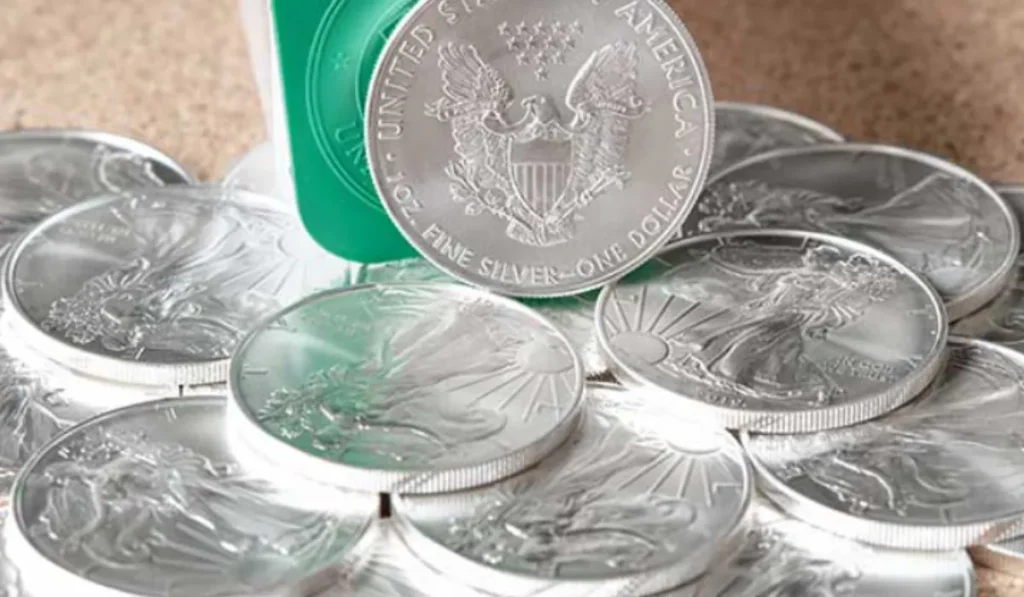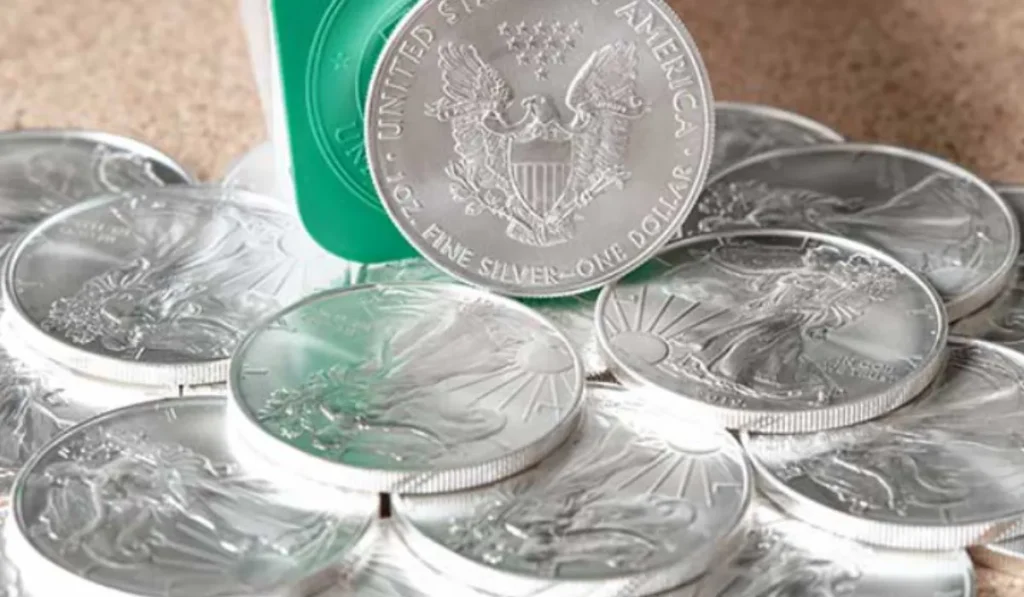The standard Silver Eagle coin weighs 31.103 grams. It’s comprised of one troy ounce of .999 fine silver.
Delving into the world of precious metals, the American Silver Eagle coin stands as a highly sought-after item among investors and collectors alike. Crafted by the United States Mint, it serves as the official silver bullion coin of the country.
An exquisite blend of beauty and value, the Silver Eagle features an iconic design that captures the essence of American heritage.
Beyond its tangible worth, this coin embodies a sense of security for those looking to diversify their investments.
Whether you’re a seasoned numismatist or a novice to the bullion market, understanding the weight and composition of the Silver Eagle is essential for making informed decisions.
Collectors and investors view the coin’s consistent weight and purity as a mark of its authenticity and quality, ensuring its place as a staple in precious metals portfolios.
Silver Eagle Defined
Imagine a treasure, shiny and precious. Now think of a coin, not just any but the Silver Eagle. Americans treasure it.
Collectors around the world seek it. What makes it special? It’s made of silver, yes, but there’s more to its tale. What exactly is a Silver Eagle? Let’s dive into its exciting journey from history’s pages to your collection.
Origins And Its Legislation
The story of the Silver Eagle starts in the United States. The year was 1986. Lawmakers said, “Let’s make a silver coin.”
They passed a law, named the Liberty Coin Act. This law birthed the Silver Eagle. It ordered that each coin must have one troy ounce of .999 pure silver. Every coin whispers a piece of American history. It stands for quality and trust.
Design And Symbolism
Turn the Silver Eagle and what do you see? On one side, Lady Liberty walks gracefully. She is the symbol of freedom and hope. This design comes from the “Walking Liberty” half dollar.
The artist, Adolph A. Weinman, crafted it in 1916. On the other side, a bald eagle. It spreads its wings in a shield. This symbolizes American strength and pride. The eagle holds arrows and an olive branch. This means America is strong but peaceful.
Physical Characteristics

The Physical Characteristics of a Silver Eagle coin tell a story of precision and value. When we dive into the world of precious metals, understanding the specifics of weight, content, and size is crucial.
Let’s explore the tangible aspects of the Silver Eagle that make it a substantial piece in the hands of investors and collectors alike.
Silver Content And Purity
At its core, the Silver Eagle boasts impressive credentials. Each coin comprises 99.9% pure silver, a testament to its high quality.
This purity level, often stamped as ‘.999 fine silver’, ensures that you hold nearly pure silver.
Dimensions And Thickness
On to its form, the Silver Eagle’s dimensions are meticulously crafted. It measures 40.6 millimeters in diameter, striking a balance between heft and manageability.
With a thickness of 2.98 millimeters, each coin feels robust and durable in your palm.
| Attribute | Measurement |
|---|---|
| Weight | 1 Troy ounce (31.103 grams) |
| Diameter | 40.6 mm |
| Thickness | 2.98 mm |
- The coin tips the scales at 1 Troy ounce, or precisely 31.103 grams.
- Its uniform size makes it stackable and easy to store.
- Investors favor its size for easy valuation and liquidity.
The Standard Weight Explained
Collectors and investors alike value the Silver Eagle for its beauty and purity. A crucial aspect of its appeal is its weight.
Troy Ounce Measurement
The weight of a Silver Eagle is expressed in troy ounces. A troy ounce is specifically used for precious metals. It’s different from the more common avoirdupois ounce. One troy ounce equals 31.103 grams.
The U.S. Mint strikes each Silver Eagle to contain one troy ounce of 99.9% pure silver. This is a strict standard known worldwide.
Comparing With Other Silver Coins
- Comparative weight with other popular coins is key.
- Silver Maple Leafs also weigh one troy ounce.
- However, some coins, like the UK’s Silver Britannias, have distinct weights.
It’s important to recognize that weights can vary slightly due to production processes. Yet, Silver Eagles are revered for their consistent weight standards.
| Coin | Weight (Troy Ounces) |
|---|---|
| Silver Eagle | 1 |
| Silver Maple Leaf | 1 |
| Silver Britannia | Varies |
Factors Affecting Weight Variation

Understanding the Factors Affecting Weight Variation of a Silver Eagle coin is crucial for collectors and investors. These factors play a role in the precise mass of each coin.
Production Process
The Production Process is the first step that influences a Silver Eagle’s weight. Each coin starts from a carefully measured amount of silver. The U.S. Mint ensures they have a mass of one troy ounce.
- Bulk silver is refined to 99.9% purity.
- Blank coins are cut to exact dimensions.
- Strict quality checks follow.
Despite these steps, subtle variations may occur.
Coins may marginally differ from the standard 31.103 grams.
Wear And Tear Over Time
Wear and Tear Over Time can affect a coin’s weight. Circulated coins are susceptible to losing small amounts of metal.
Silver Eagles used in transactions gather minor scratches and dings.
- Edges become smoother with handling.
- Surface details may erode slightly.
Collectible and investment coins typically remain close to their issued weight due to careful handling and storage.
Collectible Variations
For coin enthusiasts, the American Silver Eagle is not only a piece of precious metal but also a treasure trove of collectible variations.
Each variation brings unique weight and design elements that appeal to different collectors. Let’s delve into the world of Silver Eagles and explore the intricacies of their collectible versions.
Proof Vs. Bullion
Proof Silver Eagles and Bullion Silver Eagles are the two main types collectors love. Although both weigh the same, proof coins are known for their exceptional finish. They showcase a stunning mirror-like background with a frosted design. This combination highlights the coin’s details sharply.
- Bullion Silver Eagles: Ideal for investors, these coins have a standard finish tailored for mass production.
- Proof Silver Eagles: Preferred by collectors, crafted with extra care, and often come with a certificate of authenticity.
Special Editions And Sets
Special Editions and Sets elevate the American Silver Eagle’s status from a mere coin to a collector’s gem. These include limited releases and anniversary sets that boast unique features and packaging.
| Edition/Set | Noteworthy Aspect |
|---|---|
| Anniversary Sets | Commemorate important milestones with special packaging and sometimes even additional coins. |
| Reverse Proof Coins | Feature an inverted proof finish, offering a distinctive look with a frosted background and shiny design. |
| Uncirculated Sets | These are similar to bullion but carry a mint mark, indicating their release in a special mint set. |
Whether it’s a Mint Anniversary set or a Reverse Proof Silver Eagle, each special edition brings a unique allure. These sets and editions can weigh more due to packaging, but the coin itself maintains the standard Silver Eagle weight.
Verifying Authenticity
Verifying the authenticity of a Silver Eagle coin is crucial for collectors and investors. It ensures the value and integrity of their investment. One primary way to authenticate a Silver Eagle is by checking its weight. Let’s delve into the specifics of how weight precision and other methods help verify a genuine Silver Eagle.
Weight Precision As A Key Indicator
The official weight of a standard Silver Eagle coin is specified at 31.103 grams. This is equal to one troy ounce of silver.
A genuine Silver Eagle should adhere to this weight with minimal deviation. Precision scales can detect even the slightest difference in weight. Coins that are heavier or lighter can be red flags for counterfeits.
- A digital scale will provide the most accurate reading.
- The scale should have a precision of at least two decimal places.
- The weight should be 31.103 grams, give or take a small margin for error.
Other Methods Of Authentication
In addition to weight, there are various ways to check if a Silver Eagle is real. Here are a few methods:
- Examine the coin’s details under magnification.
- Look for the U.S. Mint’s specific design features.
- Magnetic tests: Silver is not magnetic, so a magnet should not stick.
- Perform a ring test for a distinct sound only silver makes.
For an added layer of confidence:
- Compare the coin to another known authentic Silver Eagle.
- Consider a professional coin grading service for verification.
- Check the coin’s size and thickness against official specifications.
FAQs About the Weight of A Silver Eagle
What Is The Weight Of A Silver Eagle Coin?
The standard weight of a Silver Eagle coin is 1 troy ounce. This equals approximately 31. 103 grams. The coin is made of 99. 9% pure silver.
Are All Silver Eagles 1 Troy Ounce?
Yes, all American Silver Eagle bullion coins are minted at 1 troy ounce. They maintain a consistent weight for collectability and investment purposes.
Do Proof Silver Eagles Weigh More?
No, proof Silver Eagles also weigh 1 troy ounce. They are crafted with the same weight but often have a more refined finish compared to bullion Silver Eagles.
How Does The Weight Impact Silver Eagle Value?
The weight of a Silver Eagle directly influences its value, as it’s primarily based on the current market price of silver per troy ounce. Collector demand can also affect its premium.
Conclusion
We’ve explored the specifics behind the Silver Eagle’s weight—a crucial factor for investors and collectors alike.
Remember, each coin boasts exactly one troy ounce of fine silver, offering a tangible asset in your portfolio. With this knowledge, making informed decisions about adding Silver Eagles to your collection becomes simpler and more strategic.
Happy collecting and wise investing!
Resources:
https://www.usmint.gov/coins/coin-medal-programs/american-eagle/silver-bullion
https://catalog.usmint.gov/coins/coin-programs/american-eagle-coins/
